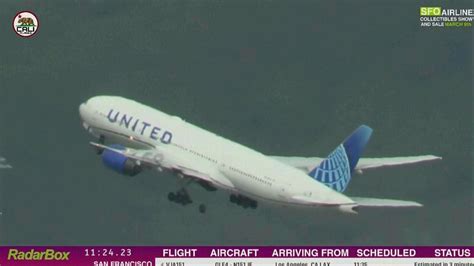
A United Airlines pilot apologized to passengers aboard a flight from Newark, New Jersey, to Denver, Colorado, after performing a rapid descent due to a suspected pressurization issue. The incident, which occurred on Sunday, prompted the pilot to deploy oxygen masks and quickly lower the aircraft’s altitude for safety.
Passengers aboard United Airlines Flight 763 experienced a concerning ordeal Sunday when the aircraft initiated a rapid descent. The flight, originating from Newark Liberty International Airport and bound for Denver International Airport, encountered what the pilot described as a potential pressurization problem. The incident led to the deployment of oxygen masks and a swift change in altitude, causing unease among those on board.
The pilot addressed the passengers following the event, expressing his remorse for the disruption and explaining the necessary actions taken to ensure their safety. According to accounts from passengers shared on social media, the pilot stated, “I’m sorry everyone, but we had to descend.” He further elaborated that the rapid descent was a precautionary measure due to a potential loss of cabin pressure, a situation that necessitates immediate action to mitigate the risk of hypoxia among passengers and crew.
“Everything’s okay now,” the pilot assured passengers after the aircraft stabilized at a lower altitude. The flight continued its journey to Denver, where it landed without further incident. Upon arrival, the aircraft was met by emergency vehicles as a standard safety protocol.
United Airlines acknowledged the incident, confirming that Flight 763 experienced a pressurization issue. The airline issued a statement saying, “United Flight 763 from Newark to Denver descended to a lower altitude after a possible pressurization issue. The flight landed safely in Denver and was met by our medical team for a review. We are working to get our customers on their way to their final destinations.”
The Federal Aviation Administration (FAA) has been notified about the incident. Although an official investigation hasn’t been publicly announced, such events typically undergo review to ascertain the precise cause and to prevent similar occurrences in the future.
Detailed Account of the Incident
United Airlines Flight 763, a regularly scheduled service connecting Newark, New Jersey, with Denver, Colorado, departed on Sunday under standard operating conditions. Passengers settled in for what was expected to be a routine flight across the country. However, approximately mid-flight, indicators in the cockpit alerted the flight crew to a potential issue with the aircraft’s pressurization system.
Cabin pressurization is a critical aspect of commercial air travel, maintaining a safe and comfortable environment for passengers and crew at high altitudes. Aircraft cabins are pressurized because at altitudes above 10,000 feet, the partial pressure of oxygen in the atmosphere is too low to adequately sustain consciousness in humans. Without pressurization, passengers could experience hypoxia, a condition characterized by a deficiency in the amount of oxygen reaching the tissues. Symptoms can include dizziness, confusion, and ultimately, loss of consciousness.
When the pilots detected the potential pressurization problem, they initiated the standard operating procedure for such an event. This involved manually deploying the oxygen masks located above each seat. Concurrently, the pilots began a rapid descent to an altitude where the atmospheric pressure is naturally higher and breathable without supplemental oxygen. The speed of the descent is critical in such situations to minimize the risk of hypoxia among those on board.
Passengers described a scene of initial confusion as the oxygen masks dropped from the overhead compartments. While pre-flight safety demonstrations illustrate the use of these masks, the sudden deployment can be alarming, especially for those who have never experienced it before. The pilots made announcements to reassure passengers, explaining the situation and the necessary actions being taken.
Following the rapid descent, the aircraft stabilized at a lower altitude, where the cabin pressure could be safely maintained. The pilots then assessed the situation, communicated with air traffic control, and determined that it was safe to continue the flight to Denver. Upon landing, medical personnel were on hand to evaluate passengers, although no serious injuries were reported.
Technical Aspects of Cabin Pressurization
Cabin pressurization systems in modern aircraft are complex and meticulously engineered to maintain a safe and comfortable environment. These systems typically use bleed air from the engines, which is cooled and then pumped into the cabin. The outflow of air is carefully regulated to maintain a consistent pressure.
The pressure inside the cabin is not the same as the pressure at sea level. Instead, aircraft typically maintain a cabin altitude equivalent to 6,000 to 8,000 feet. This reduces the stress on the aircraft’s structure while still providing a comfortable environment for passengers.
A loss of pressurization can occur due to various factors, including mechanical failure of the pressurization system, a leak in the aircraft’s fuselage, or a malfunction in the outflow valves. Aircraft are equipped with multiple redundant systems and safety mechanisms to prevent and mitigate such occurrences.
Pilots undergo rigorous training to manage pressurization issues and other emergency scenarios. This training includes both classroom instruction and simulator sessions, where they practice handling various malfunctions and system failures. The procedures for dealing with a loss of pressurization are well-defined and emphasize a rapid descent to a safe altitude.
Passenger Reactions and Social Media Response
The incident on United Airlines Flight 763 quickly gained attention on social media platforms. Passengers shared their experiences, expressing a mix of concern, relief, and gratitude for the crew’s handling of the situation.
Several passengers praised the pilot for his calm demeanor and clear communication during the event. One passenger wrote on Twitter, “Hats off to the pilot of United 763, who kept his cool and kept us informed during a stressful situation. That rapid descent was no joke.”
Others recounted the initial moments of panic and confusion when the oxygen masks deployed. “It was definitely scary when those masks dropped,” one passenger shared on Facebook. “But the crew did a good job of keeping everyone calm and explaining what was happening.”
The incident also sparked discussions about airline safety and the importance of preparedness for emergencies. Some commentators questioned the frequency of such events, while others emphasized the rarity of serious incidents in commercial aviation.
United Airlines’ response to the incident was also scrutinized on social media. While some praised the airline for its prompt communication and attention to passenger safety, others criticized the lack of detailed information provided immediately after the landing.
Regulatory Oversight and Safety Standards
Commercial aviation is subject to stringent regulatory oversight by agencies such as the FAA in the United States and the European Aviation Safety Agency (EASA) in Europe. These agencies set and enforce safety standards for aircraft design, maintenance, and operation.
Airlines are required to adhere to strict maintenance schedules to ensure that aircraft systems are functioning properly. This includes regular inspections of pressurization systems and other critical components. Pilots and crew members undergo extensive training and recurrent checks to maintain their proficiency in handling emergency situations.
The FAA and EASA also investigate incidents and accidents to identify potential safety issues and to recommend corrective actions. The findings from these investigations can lead to changes in regulations, aircraft design, or operational procedures.
The aviation industry has made significant strides in safety over the years, thanks to advances in technology, improved training, and rigorous regulatory oversight. While incidents like the one on United Airlines Flight 763 can be unsettling, they also serve as a reminder of the importance of vigilance and preparedness in ensuring the safety of air travel.
Impact on Passengers and Future Travel
The experience on Flight 763 undoubtedly left a lasting impression on the passengers involved. Events like these can trigger anxiety and fear of flying, especially for those who are already apprehensive about air travel. Airlines often provide resources and support to passengers who have been affected by such incidents, including counseling services and information about aviation safety.
Passengers who experienced the incident may also be more attentive to safety briefings and emergency procedures on future flights. They may be more likely to ask questions and seek reassurance from crew members.
The incident also highlights the importance of passengers being aware of their own health conditions and taking necessary precautions when flying. Individuals with respiratory problems or other medical conditions that could be exacerbated by changes in cabin pressure should consult with their doctors before traveling.
Expert Commentary and Analysis
Aviation safety experts have commented on the United Airlines Flight 763 incident, emphasizing the importance of pilot training and adherence to standard operating procedures.
“Pilots are trained to handle a wide range of emergency situations, including loss of cabin pressure,” said John Nance, an aviation safety consultant. “The rapid descent is a standard procedure designed to protect passengers from hypoxia. The key is for the pilots to remain calm, communicate effectively, and follow the established protocols.”
Other experts noted that while pressurization issues are relatively rare, they can occur due to various factors. “Aircraft are complex machines, and systems can sometimes malfunction,” said Emily Smith, an aerospace engineer. “The important thing is that there are redundant systems in place to mitigate the risks, and that the crew is well-trained to respond appropriately.”
Compensation and Passenger Rights
Passengers affected by incidents like the United Airlines Flight 763 pressurization issue may be entitled to compensation or other forms of redress. Airline passenger rights vary depending on the jurisdiction and the specific circumstances of the event.
In general, passengers may be entitled to compensation for delays, cancellations, or other disruptions caused by the airline. They may also be entitled to reimbursement for expenses incurred as a result of the incident, such as meals, accommodation, or transportation.
Passengers who have suffered physical or emotional harm as a result of an incident may be able to pursue legal action against the airline. The rules governing liability and compensation in such cases are complex and may vary depending on the jurisdiction.
Airlines typically have customer service departments that can assist passengers with claims for compensation or reimbursement. Passengers may also be able to seek assistance from consumer protection agencies or legal professionals.
Airline Safety Culture and Continuous Improvement
The aviation industry places a strong emphasis on safety culture and continuous improvement. Airlines are constantly striving to enhance safety through training, technology, and operational procedures.
Safety culture refers to the shared values, beliefs, and attitudes that prioritize safety above all else. A strong safety culture encourages employees to report potential hazards and to learn from mistakes.
Airlines use a variety of tools and techniques to monitor safety performance and identify areas for improvement. These include incident reporting systems, safety audits, and data analysis.
The aviation industry also benefits from collaboration and knowledge sharing. Airlines, manufacturers, regulators, and research organizations work together to improve safety standards and to develop new technologies.
The Future of Cabin Pressurization Systems
Advances in technology are leading to the development of more reliable and efficient cabin pressurization systems. New materials and designs are being used to reduce the risk of leaks and malfunctions.
Some aircraft manufacturers are exploring the use of alternative pressurization systems that do not rely on bleed air from the engines. These systems could improve fuel efficiency and reduce emissions.
Researchers are also working on developing sensors and monitoring systems that can detect pressurization problems more quickly and accurately. These systems could provide earlier warnings to pilots and allow them to take corrective action before a serious incident occurs.
Conclusion
The United Airlines Flight 763 incident serves as a reminder of the importance of safety in air travel. While such events can be unsettling, they also demonstrate the effectiveness of pilot training, standard operating procedures, and regulatory oversight in mitigating risks. The aviation industry remains committed to continuous improvement and to ensuring the safety of passengers and crew.
Frequently Asked Questions (FAQ)
1. What caused the rapid descent on United Airlines Flight 763?
The rapid descent was initiated due to a suspected pressurization issue. The pilot detected a potential problem with the aircraft’s pressurization system and, as a precautionary measure, descended to a lower altitude where the air is breathable without supplemental oxygen.
2. Were passengers in danger during the incident?
While the incident was certainly alarming, the rapid descent was a standard safety procedure designed to protect passengers from hypoxia (oxygen deprivation). The pilots followed established protocols, and the aircraft landed safely in Denver.
3. What is hypoxia, and why is it a concern in aviation?
Hypoxia is a condition where the body’s tissues don’t receive enough oxygen. At high altitudes, the air pressure is lower, meaning there is less oxygen available. Without cabin pressurization, passengers could experience hypoxia, leading to dizziness, confusion, and ultimately, loss of consciousness.
4. Will there be an investigation into the incident?
The Federal Aviation Administration (FAA) has been notified about the incident. While an official investigation hasn’t been publicly announced, such events typically undergo review to ascertain the precise cause and to prevent similar occurrences in the future. The findings from these investigations can lead to changes in regulations, aircraft design, or operational procedures.
5. Are passengers entitled to compensation after such an incident?
Passengers affected by the United Airlines Flight 763 pressurization issue may be entitled to compensation or other forms of redress. Airline passenger rights vary depending on the jurisdiction and the specific circumstances of the event. In general, passengers may be entitled to compensation for delays, cancellations, or other disruptions caused by the airline. They may also be entitled to reimbursement for expenses incurred as a result of the incident, such as meals, accommodation, or transportation.









